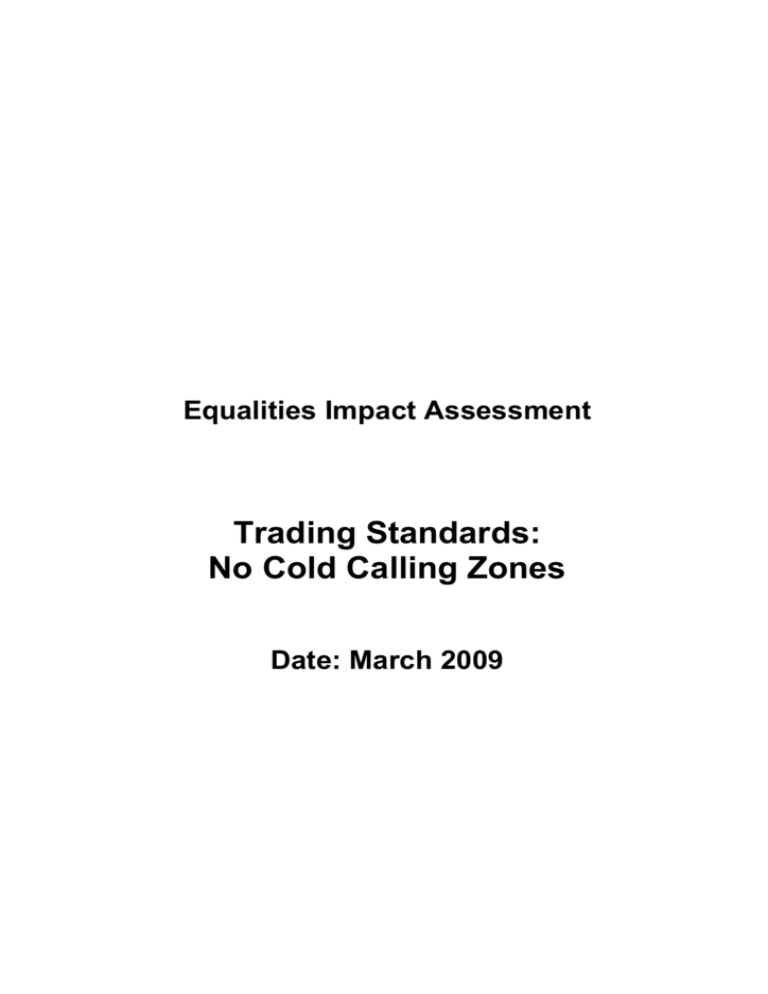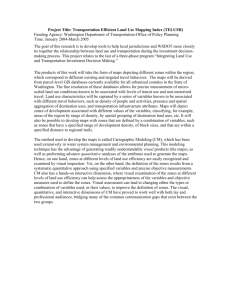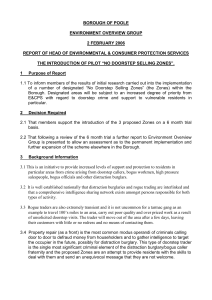No Cold Calling Zone - Leicestershire County Council
advertisement

Equalities Impact Assessment Trading Standards: No Cold Calling Zones Date: March 2009 Equality Impact Assessment: Services Title of service being assessed: Promotion and facilitation of No Cold Calling Zones Department and Section: Community Services. Trading Standards Names and roles of officers completing this assessment. Team Leader, Community Safety & Wellbeing. Lead assessor. Neighbourhood Safety Officer. Surveys Admin Officer, Management Information. Data analysis. Contact Telephone Numbers: 0116 305 6547 Date assessment completed: December 2008 Defining the service 1. What are the aims, objectives or purpose of the service? Are these reflected in the relevant service plan? To protect vulnerable householders from doorstep crime. To enable businesses to easily identify those areas where uninvited callers are unwelcome. To create an information sharing network to detect and discourage rogue traders, bogus property repair gangs and distraction burglary teams. Excerpts from Trading Standards’ Service Plan 08/09: The overall aim of the Service is to ensure a fair and safe trading environment, which promotes the well-being of citizens and allows businesses to prosper. To provide an appropriate mix of actions in all areas of trading activity so as to maintain standards of trade which protect the community against unfair trading practices and hazards. To work in partnership with other agencies including voluntary services and other local Authorities whose work complements the functions of the Service. More specifically Trading Standards will work with Adult Social Care and the corporate Community Safety team to:◊ promote safer and healthier communities through our work to:- i) tackle underage sales of alcohol, solvents, fireworks and knives - ii) combat unwanted doorstep sales with ‘No Cold Calling Zones’ ◊ help improve older people’s well-being through our work on: - i) product safety to reduce accidents in the home - ii) ‘No Cold Calling Zones’ which will help reduce the fear of crime. 2. What outcomes does the service want to achieve and for whom? How have these been determined? Please also list any relevant performance indicators. Reduction in crime - Houses within zones should receive fewer uninvited callers. This denormalises the practice of opening the door to strangers, inviting them into the home and entering into detrimental contracts. The benefit to the elderly and vulnerable is that they are less likely to be victimised, increasing the chance of their continuing to live independently. Reduction in fear of crime – Locations selected for zones are often recommended by the Police as a result of previous victimisation of residents or because of a higher than usual percentage of elderly or vulnerable people who express concern about being cheated or robbed. Establishment of a zone reassures these individuals. These desired outcomes have been identified from Home Office reports and consultations and through research conducted by many organisations including Age Concern. 3. Who is responsible for delivering the service? Are any other organisations involved? If other organisations are involved are they fully compliant with the Council’s Equality Policy? Zones are set up by a variety of bodies including residents’ groups, Neighbourhood Watch (NHW), community based Police Officers and Parish Councils. The Trading Standards Service supplies information packs for residents, signs for the streets and advice about doorstep sales legislation. In addition, Trading Standards monitor residents’ satisfaction with the zones and provide information and guidance to businesses as to the status and extent of zones. Whilst it is considered that Police, NHW and Parish Councils are fully compliant with equal opportunities Legislation and policy, the opinions and practices of individual residents are not known to us. 4. Consider the answers given in questions 1, 2 and 3 and assess whether your service results, or could result in adverse impact on or discrimination against different groups of people. If you consider that there is adverse impact or discrimination, or the potential for either, please outline below and state whether is it justifiable or legitimate and give your reasons for this. (See examples in Section 6) The necessity of a zone and its legitimacy depend upon why it is set up and whether the solution that it offers is proportionate to the problem. There is clear necessity where there is a history of doorstep crime at a particular location. If there is a history of nuisance and distress or an identifiable group of vulnerable residents there may also be a good case. We do not support the establishment of zones in locations where these criteria are not met. Groups likely to be adversely affected by the implementation of a No Cold Calling Zone are: Businesses that depend upon selling at people’s homes, particularly sellers of disability aids and potentially those from the travelling community (because of a preference to market goods and services ‘door to door’). This discrimination against certain types of business activity is justified as an effective crime prevention method. The zones have no legal status and account for less than 2% of the households in the County so their effect on the potential customer base of any organisation is minimal. The zones do not prevent legitimate businesses from seeking business through leafleting and responding to buying leads resulting from this. There is some degree of discrimination affecting the residents of zones. Younger people, those from ethnic minority backgrounds and men are likely to be under represented. Because of the way that zones are targeted, the proportion of residents over retirement age is likely to be much higher than the National or County average. Having regard to the victim profile for doorstep crime (most likely to be a single white woman in her 80s), residents of zones are also more likely to be white. The above are all considered to be justifiable and legitimate. 5. (a) If you have identified adverse impact or discrimination that is illegal you are required to take action to remedy this immediately. (b) If you have identified adverse impact or discrimination that is justifiable or legitimate, you will need to consider what actions can be taken to mitigate its effect on those groups of people. This arises out of the duty to promote good relations between people of different groups and is in keeping with the Council’s approach to social cohesion. (An example of this could be Positive Action measures which target specific members of staff). When we first started to consider No Cold Calling Zones as an option to address doorstep crime we sought to minimise the possibility that they could be considered to breach legislative provisions, inconvenience residents or adversely impact upon legitimate business activity. The following control measures are used: Zones are established in consultation with partner agencies including the Police to ensure that they cover areas where there is a history of doorstep crime or a high concentration of potentially vulnerable residents. Zones are usually just one street, never more than two, rather than attempting to establish ‘blanket coverage’. There is comprehensive consultation with residents in a proposed zone, particular notice being taken of the views of any individuals who object. All media comments regarding zones make it clear that they are to discourage rogue traders and certainly not intended to restrict the activities of catalogue sales organisations, rounds men or utility companies. Representatives of the utility companies have been canvassed for their views and invited to supply leaflets for our information packs. Details of the purpose and intent of the zones are posted on the Authority’s web site. With regards to the demography of zone residents, it is to be expected that there will be a degree of under representation of members of BME groups as there are few recorded incidents of distraction burglary among ethnic minority communities. The Home Office report, Distraction Burglary Amongst Older Adults and Minority Ethnic Communities – Findings document 197, was published in 2003: In a 5 year period, Avon & Somerset Constabulary recorded only 3 victims from a total of 312 distraction burglaries were from Asian or African-Caribbean communities and none of the recorded repellers of distraction burglary were from minority ethnic groups. Two focus groups were established. Group 2 considered distraction burglary and ethnic minority communities; it was composed of 66 Asian adults and 66 African-Caribbean adults. Participants suggested a number of reasons for the apparent lower rates of victimisation among minority ethnic communities: • Many Asian households are occupied by more than one person at high risk times • Asian women in particular are very aware of door checking procedures and will not open the door at all if they are suspicious of the caller; cultural and religious factors may determine aspects of this behaviour • African-Caribbean people will often demand to see a caller’s ID • African-Caribbean and Asian people are willing to leave callers on the doorstep with the door closed whilst the ID is checked. In 2002 The Home Office National Distraction Burglary Task Force issued a report that considered the most common victim profile and the most prevalent offenders. Their findings included the following: “The majority of victims of this crime are older people. A database run by Operation Liberal [a national Police task force established to deal with doorstep crime] in the Midlands indicates the average age of distraction burglary victims to be 81.Three quarters of all victims are female but this could largely be due to the fact that there are many more women in this age group. A large percentage of these vulnerable people live in isolation. Unlike most burglars, distraction burglary offenders are not opportunists who predominantly commit crimes close to where they live, they are extremely professional criminals who treat their crime as work. They may travel hundreds of miles in a day, committing 20 or 30 offences across as many as 10 or 15 force areas in order to avoid detection.” “It is known that a sizeable percentage of distraction burglary offenders are itinerants (often shunned by the travelling community for their behaviour), or people who are dependent on illegal drugs. They may have a predetermined amount of money that they want to ‘earn’ each day, and may go through 10 to 15 addresses to achieve this. The preparatory work of distraction burglars can often provide vital clues to their identities: 20% of all marks left by offenders are found on the front doors of dwellings. For instance, they may look, or even smell, through letterboxes to determine whether the occupants of the house fall within the vulnerable category.” Regardless of the minimal impact upon business due to the limited coverage of zones, we still need to consider whether any action is necessary to mitigate the impact of zones on legitimate businesses operated by members of the travelling community. Legislation requires that all business documents must have the true legal identity of the business and a proper address on them. It further requires that a cancellation notice in a prescribed form be served upon consumers who enter into a contract in their home; failure to serve the notice could render the contract unenforceable against the consumer resulting in no payment being due for work carried out. The requirement to include a true name and address is in order that consumers should be able to exercise their statutory rights in the event that goods or services are unsatisfactory. The requirement to serve a cancellation notice (and usually wait 7 days before commencement of work) is to allow consumers time to reconsider what could have been a decision made under pressure or duress. It seems reasonable to expect persons who travel around the country as part of their business activity will have an address at which their vehicles will be registered, taxed and insured, and an address for tax purposes. As failure to include this on business documents could result in contracts being unenforceable or even criminal proceedings, it is important that steps should be taken to bring this to their attention. Identifying and Removing Barriers to Equal Access 6. (a) Identify the ways people can find out about and use the services you provide. Consider any processes they need to go through or criteria that we apply to determine eligibility for receiving the service. List your answers in box (a) below. (b) Review those processes and criteria and consider whether any of them are essential (i.e. are they a legal requirement?) and mark accordingly in box (b). You are aiming to maintain only those processes or criteria that are critical to delivering the service. (c) Review those processes and criterion that you have decided are critical against the access needs that various equality groups of people have. Are there any groups of people who would not be able to find out about or use the service? What are the barriers that are preventing them? List your answers in box (c) Consider issues such as: How can people who are deaf/disabled or visually impaired find out about your service? What about people whose first language is not English. Is information readily available in a variety of formats e.g. other languages, large print, audio tape, easy read for people with learning difficulties? If people need to come to council offices, are these fully accessible? How easy is it for a person to make their communication needs understood? Is there good and accessible transport links to the offices? Is there parking for disabled people? How do you ensure that an individual’s preferred method of communication is known about and adhered to? Is there a quiet area for interviewing people who are deaf/disabled? Is sufficient time allocated? Are the needs of young children accompanying a service user accommodated? Can an officer attend a user’s home if, for example, a person finds it difficult or impossible to come to the offices? Have staff received sufficient and appropriate customer care and equalities awareness training to be able to deal confidently with a variety of potential access needs? (a) List Process and Criteria (b) Essential? Yes/No (a) Barriers identified and groups affected Finding out: Contact with Police following doorstep incident. Media, including press and radio. Adult Social Care. Neighbourhood Watch. Local community groups. Parish Councils. Web site. Although many individuals will only find out about the option of setting up a zone as a result of a crime, partner agencies actively signpost where there appears to be a need. The establishment of a zone is dependent upon there being a local ‘champion’ prepared to organise it. In such cases we attempt to arrange for Police / NHW etc. to be involved but will (in exceptional circumstances) do it ourselves. This option may however cease to be available once funding for the Neighbourhood Safety Officer post runs out in June 2009, at which time the Authority’s role will virtually end. Consultation with other residents. Yes. Pre-existing tensions (potentially including racism/homophobia) between neighbours may hamper this process. Obtain/distribute information packs. Yes. All residents in a proposed zone are provided with information packs. Packs are available in Braille, but not in different languages. Installation of signs. Yes Requires fitness and agility may be difficult for elderly or disabled. Processes: 6. (d)Based on your answers for (a),(b) and (c) consider what barriers you can remove, what reasonable adjustment may be necessary to ensure the service is accessible (this could include providing the service elsewhere). Consider what actions you will need to take to address any unmet needs that you have identified. For disabled people, as defined under the Disability Discrimination Act, this could mean treating them more favourably to ensure that there is equality of outcome. When you are deciding priorities for action you will need to consider whether the barriers result in an adverse impact or discrimination that is illegal. These will constitute your top priority. The other priorities will be dependent on such issues as whether a group is particularly excluded or connected to the core business of the service, whether there are adjustments that would mean several groups benefit. The consultation process is usually conducted by a Neighbourhood Watch coordinator, Police Officer (including PCSOs), Parish Councillor or a housing association warden; there is minimal scope for personalities to frustrate an inclusive approach. On rare occasions the process may be led by an individual resident; by default the local champion will be well motivated and we do seek assurances that all residents have been approached. We require a substantial majority of households to approve of becoming a zone before we assist with implementation, minimising the impact that the preferences or prejudice of an individual could have: If individuals were missed who would have objected, our expectation of the majority of households approving would result in the outcome being unaffected unless more than half of all the residents were missed. If those missed would have approved, their not being consulted would potentially stop the zone from going ahead, against the aim of the organiser. Whilst packs have been prepared for the visually impaired, we have yet to receive a request for information in languages other than English. As indicated above, zones are likely to be coordinated by a highly motivated individual and in many cases it is envisaged that language difficulties will be overcome through ad-hoc local arrangements. If problems are encountered, it will be necessary to explore the possibility of foreign language guidance and more formal interpretation provision. Provision has been made for installation of signs by HTWM in cases where the local organisers are unable to do it. Demographic comparison between Leicestershire and zones. Group Leicestershire % Leicestershire Police CIS Distraction burglary crime statistics 07/08 % Male 49.6 28 Female 50.4 72 Zone residents % Figures for zones exclude those where no reply was given. 30.0 70.0 Under 19 24.1 0 0.0 20-34 35-44 45-54 55-64 65 + 17.6 15.5 13.6 13.9 16.3 1 2 3.6 6.9 9.5 12.8 67.0 White British or Irish White other Mixed Indian Black Chinese 93.3 95 1 0.96 4.62 0.6 0.1 1 96.0 1.1 0.0 2.6 0.3 0.0 Disabled 15.5 Not available 28.3 3 90 The profile of residents is clearly weighted towards elderly white females and to those with disabilities. This fits well with the recognised victim profile for doorstep crime. This shows that, to date, zones have indeed been effectively targeted to achieve the greatest benefit to vulnerable residents whilst minimising the restrictions placed upon legitimate businesses. Ensure that the actions you identify are put into the attached equality improvement plan. If you do not have the authority to take the action required, you will need to alert the relevant service manager of your findings. Ensuring Continuous Equality Improvement 7. The council is committed to mainstreaming equality, ensuring that it is integrated into our performance management frameworks and subject to continuous improvement through performance monitoring. Essentially, if you are not monitoring, you do not know what impact your service is having or whether you are meeting people’s needs. The table below shows examples of several types and sources of performance information that we collect as a council, some is collected corporately and some will be collected within individual services. Review what data you have and consider the following questions: (a) What does analysis of the data tell you about how well your service is meeting the needs of the various equality groups? Are there any unmet needs or concerns that need to be addressed? How up to date is the information? (b) Which groups of people are you hearing from? Are there groups of people that you are not hearing from? What can you do to ensure that people are able to provide feedback on the service? Is there information on service user needs held by other services that would be appropriate for your services? Note your answers to these questions in the 3rd and 4th column below. Data Type Source(s) Analysis of the data and/or gaps in information When last gathered Responses to zone residents’ satisfaction surveys Through Community Services Information & Marketing Team This information will only determine the perception of those who elect to respond. Ongoing. Last return Nov 08. Doorstep Crime statistics for Leicestershire Leicestershire Police via Chief Execs Research & Information. Various – last provided December 2008 Demographic data for Leicestershire identifying concentrations of elderly residents. Census, population, deprivation and other social statistics – Research Team Data sets may be too large to be entirely valid at street level so need comparison with local information provided by partners. Data sets may be too large to be entirely valid at street level so need comparison with local information provided by partners. Various – last provided December 2008 Next census due in 2011 Team discussions around service provision Locally held Information from Local Police. PCSOs, NHW coordinators, Crime Reduction Officers. Members of the team have Ongoing regular contact with other agencies and with members of the public, but have to take into account that information received this way will inevitably be the view of the most vocal rather than that of the majority. The anecdotal evidence upon Ongoing which they base their requests for the establishment of a zone needs to be tested through analysis of statistical data and any discrepancy explored. OPPORTUNITIES FOR SOCIAL COHESION OR PROMOTING GOOD RELATIONS BETWEEN DIFFERENT GROUPS OF PEOPLE 8. Social cohesion is a priority for Councils. Progress made towards building more cohesive, empowered and active communities is now being measured through national Performance Indicators. Essentially social cohesion is about promoting a sense of connection, trust and belonging both within and across communities and groups. Review all the actions and targets that you have identified as a result of this equality impact assessment to what social cohesion issues could arise, for example: these should include: (b) Are there ways in which your service could bring different groups of people together, for example to develop future provision? (c) Are there ways in which existing groups could interact with the service, for example, as part of ongoing monitoring of service provision? (d) Could the way you provide the service bring different groups of people together to use the service? (e) Does the way in which your service is provided have the potential to lead to resentment between different groups of people? How can you compensate for perceptions of preferential or differential treatment? (f) If the improvement plan identifies addressing a gap in the service for a particular group of people, has this also addressed the potential for perceptions of preferential treatment for the group? (For example, if you give priority treatment to disabled people, how will you manage the negative attitudes that non-disabled people may develop as a result.) (g) How can your service explicitly demonstrate the council’s commitment to promote equality across race, gender, disability, age, religion/belief and the LGBT communities? List your answers below. Ensure that the actions you identify are put into the attached equality improvement plan. The consultation process prior to a zone being established leads to neighbours speaking to each other, sometimes for the first time. Zones rely upon cooperation between residents if they are to be effective; as such, they are likely to promote social cohesion and break down barriers. 9. EQUALITY IMPROVEMENT PLAN Please list all the equality objectives, actions and targets that result from the Equality Impact Assessment (continue on separate sheets as necessary). These now need to be included in the relevant service plan for mainstreaming and performance management purposes. Equality Objective Ensure that businesses from the travelling community are aware of Legislative provisions relating to doorstep sales. Ensure that zones are only set up where they are needed. Action To produce and disseminate an easy to understand guide for businesses who enter into contracts in the homes of their customers. Establish system to check zone requests against demographic and crime data in order to verify local perception that zones are necessary and proportionate. Target Officer responsible By when Distribute to all Leicestershire Travellers Sites and make available to liaison officers / Police etc. Community safety Summer 2009 and wellbeing officer All zone requests checked prior to provision of road signs and information packs. Where there are doubts, results of consultation and negotiation to be considered by Team Leader or Unit Head. Neighborhood Summer 2009 Safety Officer/ Advice Officer/ Team Leader, Community Safety & Wellbeing. lead assessor. Head of Consumer Services 1st Authorised signature (EIA Lead) …Community Safety and Wellbeing Lead Assessor Date: 17th March 2009. 2nd Authorised signature (Member of DMT) ……… Head of Regulatory Services Date: ……17th March 2009 Once completed and authorised, please send a copy of this form to the Equality and Diversity Team in the Chief Executives Department.





